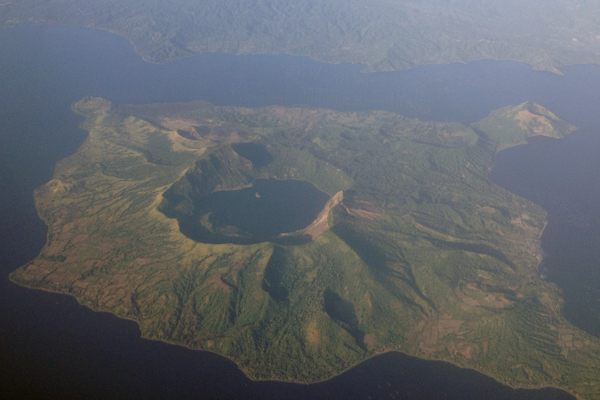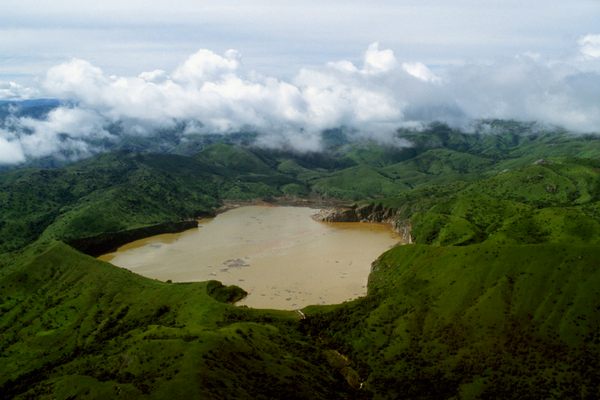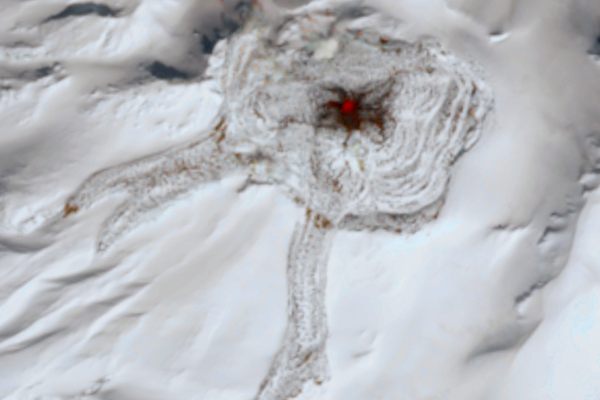Things Within Things Which Are the Same Things
Matryoshka dolls are the famed Russian creation where each little person opens into a yet smaller person. Oddly satisfying, aren’t they? But what about volcanoes inside volcanoes, or a castle inside another castle?
We’ve rounded up exactly that, a list of things within the same thing (occasionally within the same thing again).
Vulcan Point
Philippines
Island within an island within an island (Wikimedia)
Vulcan Point in the Philippines is a volcanic island in the middle of a lake on an island that is itself on a lake within an island. It’s confusing, so let’s break it down:
- There’s an island in the Philippines called Luzon.
- On this island, there’s a lake called Lake Taal. On this lake, there’s an island called Volcano Island.
- On Volcano Island, there’s a lake called Main Crater Lake. On this lake, there’s an island called Vulcan Point, formed by the tip of the Taal Volcano.
About 30 miles south of Manila, the Taal Volcano is designated a “Decade Volcano,” indicating it is worthy of study to prevent future disasters. One of the most devastating eruptions occurred in the early morning of January 30, 1911, when people on the island were awoken by what sounded like thunder and looked like lightning. In reality, Taal had erupted, driving an estimated 80 million cubic meters of solid ash and mud down the slopes of the volcano. Around 1,300 people died, practically all from scalding by hot mud or steam.
Krak des Chevaliers
Syria
Castle within a castle (via Wikimedia)
Located in Syria, Krak des Chevaliers is one of the best preserved Crusader castles from the 11th century. In the 13th century, it was developed into a concentric castle, which means that within the larger grounds of the castle walls, a second castle with higher walls was constructed. The outer castle walls protected the inhabitants from siege weapons, while the inner castle walls allowed defenders to fight back with crossbows.
The castle got its name from the Knights Hospitaller, who held it from 1142 to 1271. The order of knights controlled a number of castles on the border of the Tripoli, and Krak des Chevaliers was among the most important, functioning as an administrative center and a military base.
During the recent Syrian conflict, parts of the castle were damaged by shelling.
via Wikimedia
Fushimi Inari Taisha
Japan
Gates within gates ad infinitum (via Wikimedia)
Founded in 711 and designed the head shrine to Inari, the Japanese kami of merchants and rice, Fushimi Inari Taisha (伏見稲荷大社) is probably better known for its thousands of nested gates that lead from the main gate to the inner shrine. Each torii gate at the temple was donated by a Japanese business. In 965, the shrine was included among the 16 that received written accounts of important events when Emperor Murakami decreed that the guardian kami of Japan should be kept up to date to best defend the nation.
At the entrance to the shrine are a few stands selling tsujiura senbei (辻占煎餅), a snack dating back to the 19th century that is believed to be the origin of the popular fortune cookie now served alongside your kung pao chicken with lo mein.
via Wikimedia
Aogashima Island
Japan
Volcano within a volcano (Wikimedia)
Aogashima (青ヶ島) is an island administered by Japan and located in the Philippine Sea. The whole island is a class-C active volcano that last erupted over a four year period from 1781 to 1785, killing almost half of the local population. As of 2014, the island is inhabited by only 170 Japanese people.
For our purposes, all you have to know is that the volcano’s caldera has a secondary cone named Maruyama (丸山), forming a volcano within another volcano.
It doesn’t seem like anywhere I’d want to live since the lava probably just fills up the first volcano and that can’t be good for your stuff.
Maya Devi Temple
Nepal
Wooden temple within brick temples (via Wikimedia)
Lumbini, Nepal, is said to be the birthplace of the man who would come to be known as Buddha, and in this sacred UNESCO World Heritage Site, the Maya Devi Temple dates back to the third century BCE. With its sacred pool and garden, the Buddhist temple itself has been quite an attraction, but in 2013, a sixth-century BCE ancient tree shrine was discovered under the temple by archaeologists.
This small shrine is possibly the earliest evidence of Buddhist structures ever found, and was located under a nested series of brick temples below the current temple. The mineralized tree roots in the structure of the temple fit well with Buddhist beliefs that associate shrines with trees, particularly since Buddha was said to have been born under a tree.
Cenote Angelita
Mexico
photograph by nonperturbative/Flickr user
In Mexico’s Yucatan Peninsula, there is a submerged cave made out of collapsed limestone called the Cenote Angelita (“Little Angel”). Divers in the cave experience a unique phenomenon called a halocline, where waters of different salinity form into layers due to density. Since the dense saltwater stays at the bottom of the cave, it looks like a river flowing along a bigger underground river.
Cenotes, which are natural pits or sinkholes, were traditionally been used by the ancient Maya for sacrificial offerings, so there may be gruesome surprises for intrepid explorers lurking in this river within a river. One particular cult was known to worship the rain god Chaac by ritually casting people into particularly sacred cenotes.
Rat King
As the final thing within a thing, we will cheat a little, partially because rat kings are so awesome.
Rat king in Germany’s Naturkundliches Museum (via Wikimedia)
It’s a phenomenon that supposedly arises when a number of rats accidentally get stuck together with a goo made up of blood, dirt, ice, feces, or simply the knotting of their various tails.
The original German term, Rattenkönig, was adopted into English as rat king, and it refers to Medieval beliefs that the rat king was actually one animal with many bodies. Legends even grew around the thought that a king rat would sit on the tails of the other rats, overseeing the movements of the animals as they skittered along with their little paws. Kinda like a rat surfing on other rats, which should be enough to make you royalty already.
Preserved rat king in the Muséum d’histoire naturelle de Nantes (via Wikimedia)
One rat king specimen found in 1963 by a Dutch farmer consisted of seven rats. X-rays done on the calluses growing on the fractured tails show that the animals survived for a long period of time with their tails tangled. However, despite the fascinating idea of rats within rats, the rat king is widely regarded as a macabre myth.




















Follow us on Twitter to get the latest on the world's hidden wonders.
Like us on Facebook to get the latest on the world's hidden wonders.
Follow us on Twitter Like us on Facebook